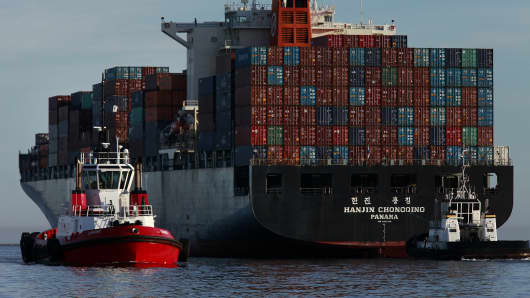So what are the deal's chances for passage? The politics of trade apparently depend — mostly — on how much individual regions stand to gain.
Though the accord faces a tough fight in Congress, the battle so far has largely ignored party lines. Rather, much — but not all — of congressional support for expanding Asian trade depends on the importance of those exports to state's economies, based on a CNBC state-by-state analysis of exports to Asian countries.
A majority of Americans supports new trade deals, according to a Reuters/Ipsos poll in May, despite opposition from unions and anti-trade activists. The poll, taken in the week that ended May 27, found that 56 percent of Americans support new trade deals, with just 13 percent opposed. Thirty-one percent were undecided.
Exports make up nearly 14 percent of the U.S. economy, the biggest share since the end of World War II, according to a recent report by HSBC. Thanks to its proximity and size, Canada is expected to remain the top export market for U.S. goods for the foreseeable future. But HSBC projects that by 2030, China will edge out Mexico as the second- largest U.S. trading partner. By then, Korea is expected to become the fourth largest, followed by Brazil, edging Japan out of the top five. Further down the list, China, India, Malaysia and Vietnam are seen as the fastest-growing markets for American goods, with growth of about 9 percent a year, according to HSBC.
Read More Despite failure in Congress, Pacific trade deal can happen
That's why the TPP, if completed, would be the biggest U.S. trade pact since 1994, when the North American Free Trade Agreement opened up trade between the United States, Canada and Mexico. But opponents of freer trade with Asia blame NAFTA for the wave of U.S. factory closures and job losses that have accompanied globalization in the decades since.
"TPP will be a disaster for American workers," Bernie Sanders, the Vermont senator running for president, told a union rally in April.
But the trade deal is strongly supported by businesses seeking to boost exports in the world's fastest growing markets. Much of the Senate support for trade authority came from states with the most to gain from increased trade with Asia.
Thanks to Asia's voracious thirst for Texas oil and gas, for example, the state is the top exporter in the nation, according to Census Department data. Both Republican senators — John Cornyn and presidential candidate Ted Cruz — voted to give the White House trade authority despite strong opposition to the rest of the Obama administration's agenda.






